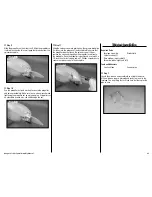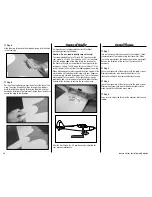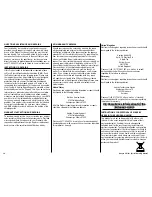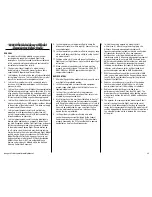
35
Hangar 9 Toledo Special Assembly Manual
2009 official Academy of Model
Aeronautics Safety Code
GENERAL
1. A model aircraft shall be defined as a non-human-
carrying device capable of sustained flight in the
atmosphere. It shall not exceed limitations established
in this code and is intended to be used exclusively for
recreational or competition activity.
2. The maximum takeoff weight of a model aircraft,
including fuel, is 55 pounds, except for those flown
under the AMA Experimental Aircraft Rules.
3. I will abide by this Safety Code and all rules established
for the flying site I use. I will not willfully fly my model
aircraft in a reckless and/or dangerous manner.
4. I will not fly my model aircraft in sanctioned events,
air shows, or model demonstrations until it has been
proven airworthy.
5. I will not fly my model aircraft higher than approximately
400 feet above ground level, when within three (3) miles
of an airport without notifying the airport operator. I will
yield the right-of-way and avoid flying in the proximity of
full-scale aircraft, utilizing a spotter when appropriate.
6. I will not fly my model aircraft unless it is identified with
my name and address, or AMA number, inside or affixed
to the outside of the model aircraft. This does not apply
to model aircraft flown indoors.
7. I will not operate model aircraft with metal-blade
propellers or with gaseous boosts (other than air),
nor will I operate model aircraft with fuels containing
tetranitromethane or hydrazine.
8. I will not operate model aircraft carrying pyrotechnic
devices which explode burn, or propel a projectile of
any kind. Exceptions include Free Flight fuses or devices
that burn producing smoke and are securely attached
to the model aircraft during flight. Rocket motors up
to a G-series size may be used, provided they remain
firmly attached to the model aircraft during flight. Model
rockets may be flown in accordance with the National
Model Rocketry Safety Code; however, they may not
be launched from model aircraft. Officially designated
AMAAir Show Teams (AST) are authorized to use
devices and practices as defined within the Air Show
Advisory Committee Document.
9. I will not operate my model aircraft while under the
influence of alcohol or within eight (8) hours of having
consumed alcohol.
10. I will not operate my model aircraft while using any drug
which could adversely affect my ability to safely control
my model aircraft.
11. Children under six (6) years old are only allowed on a
flightline or in a flight area as a pilot or while under flight
instruction.
12. When and where required by rule, helmets must be
properly worn and fastened. They must be OSHA, DOT,
ANSI, SNELL or NOCSAE approved or comply with
comparable standards.
RADIO CONTROL
1. All model flying shall be conducted in a manner to avoid
over flight of unprotected people.
2. I will have completed a successful radio equipment
ground-range check before the first flight of a new or
repaired model aircraft.
3. I will not fly my model aircraft in the presence of
spectators until I become a proficient flier, unless I am
assisted by an experienced pilot.
4. At all flying sites a line must be established, in front of
which all flying takes place. Only personnel associated
with flying the model aircraft are allowed at or in front of
the line. In the case of airshows demonstrations straight
line must be established. An area away from the line
must be maintained for spectators. Intentional flying
behind the line is prohibited.
5. I will operate my model aircraft using only radio-
control frequencies currently allowed by the Federal
Communications Commission (FCC). Only individuals
properly licensed by the FCC are authorized to operate
equipment on Amateur Band frequencies.
6. I will not knowingly operate my model aircraft
within three (3) miles of any preexisting flying site
without a frequency-management agreement. A
frequencymanagement agreement may be an allocation
of frequencies for each site, a day-use agreement
between sites, or testing which determines that no
interference exists. A frequency-management agreement
may exist between two or more AMA chartered clubs,
AMA clubs and individual AMA members, or individual
AMA members. Frequency-management agreements,
including an interference test report if the agreement
indicates no interference exists, will be signed by all
parties and copies provided to AMA Headquarters.
7. With the exception of events flown under official AMA
rules, no powered model may be flown outdoors closer
than 25 feet to any individual, except for the pilot and
located at the flightline.
8. Under no circumstances may a pilot or other person
touch a model aircraft in flight while it is still under
power, except to divert it from striking an individual.
9. Radio-controlled night flying is limited to low-
performance model aircraft (less than 100 mph). The
model aircraft must be equipped with a lighting system
which clearly defines the aircraft’s attitude and direction
at all times.
10. The operator of a radio-controlled model aircraft shall
control it during the entire flight, maintaining visual
contact without enhancement other than by corrective
lenses that are prescribed for the pilot. No model aircraft
shall be equipped with devices which allow it to be flown
to a selected location which is beyond the visual range
of the pilot.


































